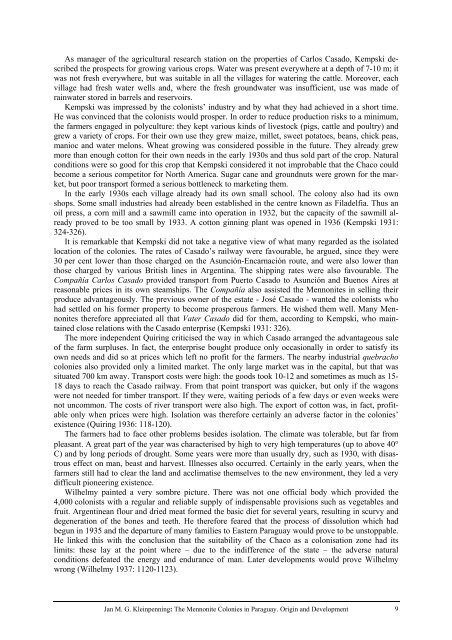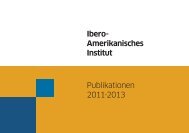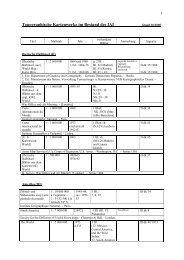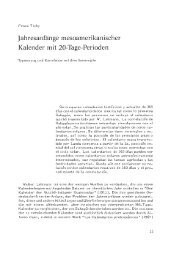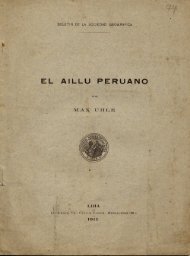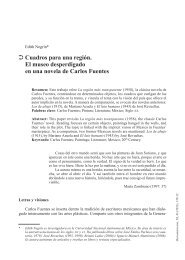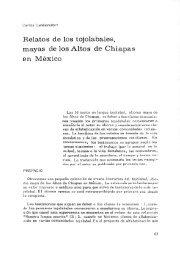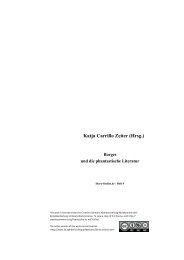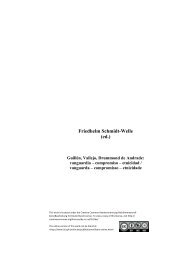The Mennonite Colonies in Paraguay. Origin - Ibero-Amerikanisches ...
The Mennonite Colonies in Paraguay. Origin - Ibero-Amerikanisches ...
The Mennonite Colonies in Paraguay. Origin - Ibero-Amerikanisches ...
You also want an ePaper? Increase the reach of your titles
YUMPU automatically turns print PDFs into web optimized ePapers that Google loves.
As manager of the agricultural research station on the properties of Carlos Casado, Kempski described<br />
the prospects for grow<strong>in</strong>g various crops. Water was present everywhere at a depth of 7-10 m; it<br />
was not fresh everywhere, but was suitable <strong>in</strong> all the villages for water<strong>in</strong>g the cattle. Moreover, each<br />
village had fresh water wells and, where the fresh groundwater was <strong>in</strong>sufficient, use was made of<br />
ra<strong>in</strong>water stored <strong>in</strong> barrels and reservoirs.<br />
Kempski was impressed by the colonists’ <strong>in</strong>dustry and by what they had achieved <strong>in</strong> a short time.<br />
He was conv<strong>in</strong>ced that the colonists would prosper. In order to reduce production risks to a m<strong>in</strong>imum,<br />
the farmers engaged <strong>in</strong> polyculture: they kept various k<strong>in</strong>ds of livestock (pigs, cattle and poultry) and<br />
grew a variety of crops. For their own use they grew maize, millet, sweet potatoes, beans, chick peas,<br />
manioc and water melons. Wheat grow<strong>in</strong>g was considered possible <strong>in</strong> the future. <strong>The</strong>y already grew<br />
more than enough cotton for their own needs <strong>in</strong> the early 1930s and thus sold part of the crop. Natural<br />
conditions were so good for this crop that Kempski considered it not improbable that the Chaco could<br />
become a serious competitor for North America. Sugar cane and groundnuts were grown for the market,<br />
but poor transport formed a serious bottleneck to market<strong>in</strong>g them.<br />
In the early 1930s each village already had its own small school. <strong>The</strong> colony also had its own<br />
shops. Some small <strong>in</strong>dustries had already been established <strong>in</strong> the centre known as Filadelfia. Thus an<br />
oil press, a corn mill and a sawmill came <strong>in</strong>to operation <strong>in</strong> 1932, but the capacity of the sawmill already<br />
proved to be too small by 1933. A cotton g<strong>in</strong>n<strong>in</strong>g plant was opened <strong>in</strong> 1936 (Kempski 1931:<br />
324-326).<br />
It is remarkable that Kempski did not take a negative view of what many regarded as the isolated<br />
location of the colonies. <strong>The</strong> rates of Casado’s railway were favourable, he argued, s<strong>in</strong>ce they were<br />
30 per cent lower than those charged on the Asunción-Encarnación route, and were also lower than<br />
those charged by various British l<strong>in</strong>es <strong>in</strong> Argent<strong>in</strong>a. <strong>The</strong> shipp<strong>in</strong>g rates were also favourable. <strong>The</strong><br />
Compañía Carlos Casado provided transport from Puerto Casado to Asunción and Buenos Aires at<br />
reasonable prices <strong>in</strong> its own steamships. <strong>The</strong> Compañía also assisted the <strong>Mennonite</strong>s <strong>in</strong> sell<strong>in</strong>g their<br />
produce advantageously. <strong>The</strong> previous owner of the estate - José Casado - wanted the colonists who<br />
had settled on his former property to become prosperous farmers. He wished them well. Many <strong>Mennonite</strong>s<br />
therefore appreciated all that Vater Casado did for them, accord<strong>in</strong>g to Kempski, who ma<strong>in</strong>ta<strong>in</strong>ed<br />
close relations with the Casado enterprise (Kempski 1931: 326).<br />
<strong>The</strong> more <strong>in</strong>dependent Quir<strong>in</strong>g criticised the way <strong>in</strong> which Casado arranged the advantageous sale<br />
of the farm surpluses. In fact, the enterprise bought produce only occasionally <strong>in</strong> order to satisfy its<br />
own needs and did so at prices which left no profit for the farmers. <strong>The</strong> nearby <strong>in</strong>dustrial quebracho<br />
colonies also provided only a limited market. <strong>The</strong> only large market was <strong>in</strong> the capital, but that was<br />
situated 700 km away. Transport costs were high: the goods took 10-12 and sometimes as much as 15-<br />
18 days to reach the Casado railway. From that po<strong>in</strong>t transport was quicker, but only if the wagons<br />
were not needed for timber transport. If they were, wait<strong>in</strong>g periods of a few days or even weeks were<br />
not uncommon. <strong>The</strong> costs of river transport were also high. <strong>The</strong> export of cotton was, <strong>in</strong> fact, profitable<br />
only when prices were high. Isolation was therefore certa<strong>in</strong>ly an adverse factor <strong>in</strong> the colonies’<br />
existence (Quir<strong>in</strong>g 1936: 118-120).<br />
<strong>The</strong> farmers had to face other problems besides isolation. <strong>The</strong> climate was tolerable, but far from<br />
pleasant. A great part of the year was characterised by high to very high temperatures (up to above 40°<br />
C) and by long periods of drought. Some years were more than usually dry, such as 1930, with disastrous<br />
effect on man, beast and harvest. Illnesses also occurred. Certa<strong>in</strong>ly <strong>in</strong> the early years, when the<br />
farmers still had to clear the land and acclimatise themselves to the new environment, they led a very<br />
difficult pioneer<strong>in</strong>g existence.<br />
Wilhelmy pa<strong>in</strong>ted a very sombre picture. <strong>The</strong>re was not one official body which provided the<br />
4,000 colonists with a regular and reliable supply of <strong>in</strong>dispensable provisions such as vegetables and<br />
fruit. Argent<strong>in</strong>ean flour and dried meat formed the basic diet for several years, result<strong>in</strong>g <strong>in</strong> scurvy and<br />
degeneration of the bones and teeth. He therefore feared that the process of dissolution which had<br />
begun <strong>in</strong> 1935 and the departure of many families to Eastern <strong>Paraguay</strong> would prove to be unstoppable.<br />
He l<strong>in</strong>ked this with the conclusion that the suitability of the Chaco as a colonisation zone had its<br />
limits: these lay at the po<strong>in</strong>t where – due to the <strong>in</strong>difference of the state – the adverse natural<br />
conditions defeated the energy and endurance of man. Later developments would prove Wilhelmy<br />
wrong (Wilhelmy 1937: 1120-1123).<br />
Jan M. G. Kle<strong>in</strong>penn<strong>in</strong>g: <strong>The</strong> <strong>Mennonite</strong> <strong>Colonies</strong> <strong>in</strong> <strong>Paraguay</strong>. Orig<strong>in</strong> and Development<br />
9


